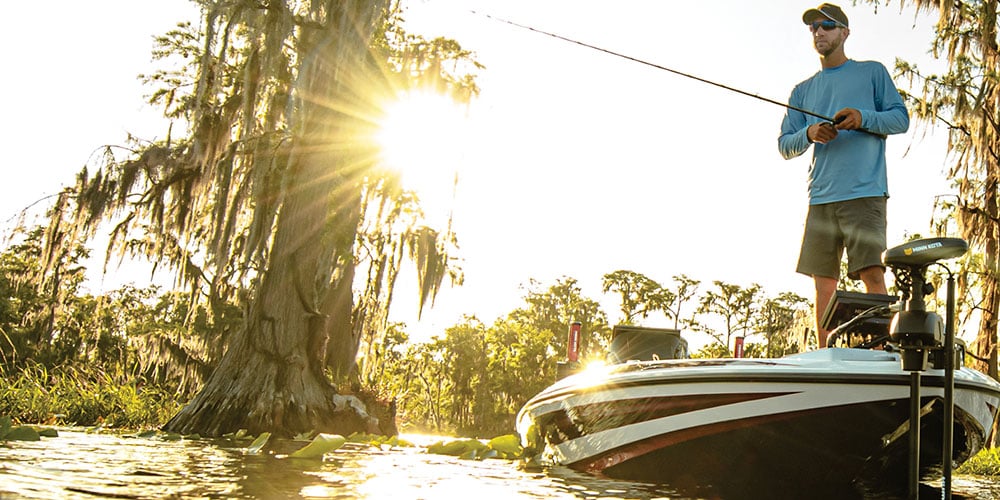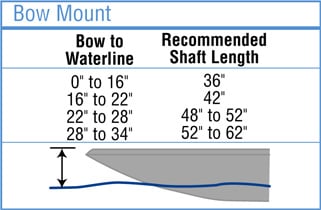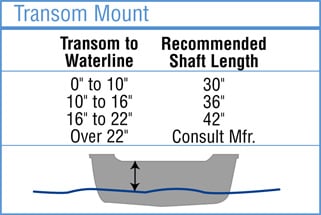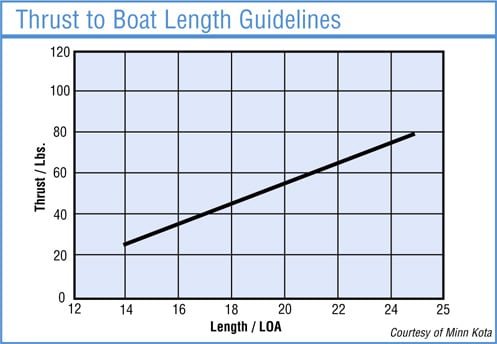
What to Consider When Choosing a Trolling Motor
Bow-Mount Motors

Note: Add 8" to your bow to waterline measurement if large waves are often present where you fish.
Bow mounted motors are convenient if you fish primarily in an open bow-rider or on the fore-deck of a bass boat. To prevent damage from groundings, a spring-loaded mount like Minn Kota’s BowGuard 360 allows the motor to swing away on impact. On very small craft or on a light sailboat the trolling motor often doubles as an auxiliary engine and is mounted on the transom where it is operated by a tiller.
Transom-Mount Motors
Transom-mount trolling motors are a good choice for anglers who tend to operate at the back of the boat or cockpit or for sailboat owners who use a trolling motor as an auxiliary means of propulsion that has to be operated from the helm’s position. Transom mount trolling motors have brackets that adjust to different angles and heights so the motor’s shaft is immersed to the proper depth.

Fresh vs. Saltwater
Saltwater motors are protected against corrosion and have better seals on the mechanical and electrical components.
Shaft Length
The standard shaft length is 42". To determine the right length for your boat, measure the distance from where the shaft is mounted on the deck or the transom to the water. Then add 16" (for MotorGuide) or 20" (for Minn Kota) and select the next closest measurement. We recommend longer shafts for operation in rough water so the prop stays about 6" below the surface when the boat pitches and rolls. If you frequently fish in rough water, add 8" to your bow to waterline measurement and choose the shaft length accordingly. If your measurement falls within the overlapping ranges, select the longer shaft length. Fine-tune the motor’s vertical position with the adjustment on the mount.
Thrust
Trolling motors are rated in pounds of thrust. As a rule of thumb 72 to 75lb. of thrust roughly equals one horsepower or 746W of electrical power. A typical 12V motor that draws 60A consumes approximately 720W. The equation for power is easy: the higher the voltage, the higher the thrust. Trolling motors are offered in 12V, 12/24V, 24V and 36V versions, with the most powerful ones offering more than 100lb. of thrust, powerful enough to move heavy vessels such as pontoon boats. Maximum thrusts at different voltages are approximately 12V/55lb. and 24V/80lb.

The Right Size
Bigger is almost always better. Larger boats need more juice, but we recommend you consider wave action, wind and current when choosing a trolling motor. Erring on the stronger side has its benefits because stronger motors run more efficiently at lower speeds and provide a safety cushion for handling wind, waves and current. We recommend 5lb. of thrust for every 200lb. of a vessel’s gross weight.
Power Consumption
Think about the size of your boat, how much battery capacity you can safely install to satisfy the energy demands of a trolling motor, and whether or not you will be able to charge the batteries when underway. Check the amp draw of the models you have in mind. A 24V model with 54lb. of thrust may only draw 28A, while a 12V model with 44lb. of thrust can draw 36A. The rule of thumb is that larger motors require more battery capacity, and if you fish from dawn to dark with a boat of 16' or longer, you’ll probably want 24V. Serious anglers who spend a lot of time on the water will appreciate a 36V motor.
Advanced Features
Many trolling motors now feature autopilot and route storage capabilities to guide you through your most productive routes. With Bluetooth connectivity, you can control these features from your phone or from an included remote control. Some Minn Kota motors feature Humminbird's MEGA Down Imaging and are compatible with select fishfinders.
Trolling Motor FAQ
How do I maintain my trolling motor to ensure longevity?
Regular maintenance is crucial for longevity. Rinse your motor with fresh water after use, especially in saltwater environments, and check for any debris around the propeller. Lubricate moving parts as recommended by the manufacturer, and inspect the electrical components for corrosion or wear.
Can I use a freshwater trolling motor in saltwater?
It’s not recommended. Freshwater motors lack the corrosion protection and seals needed for saltwater use. If you must use a freshwater motor in saltwater, rinse it thoroughly with fresh water after each use to minimize damage, but it’s better to invest in a saltwater-specific motor.
What is the difference between a tiller handle and a foot pedal for controlling a trolling motor?
A tiller handle is a more traditional and straightforward control system where you steer directly by hand. Foot pedals offer hands-free control, allowing you to steer and control speed using your feet, which is particularly helpful for fishing as it frees up your hands.
Can I use a trolling motor on a kayak or canoe?
Yes, many trolling motors are designed for small watercraft like kayaks and canoes. Ensure that the motor's thrust rating matches your kayak’s size, and opt for lighter, more compact models to avoid adding too much weight to your boat.
How do I calculate battery life for my trolling motor?
To estimate battery life, divide the battery’s amp-hour rating by the motor's amp draw. For example, if your motor draws 20A and your battery is rated at 100Ah, it will last approximately 5 hours. Keep in mind that running the motor at lower speeds can significantly extend battery life.
Can I use a solar panel to charge my trolling motor’s battery?
Yes, solar panels can charge trolling motor batteries, but the effectiveness depends on the size and output of the solar panel. For adequate performance, choose a high-output panel paired with a charge controller to protect the battery from overcharging.
What is the best way to store a trolling motor during the off-season?
Remove the motor from the boat, clean it thoroughly, and store it in a dry, cool place. Make sure the motor is fully dried to prevent corrosion, especially in saltwater motors. Disconnect the battery, and if possible, store the battery indoors and keep it charged periodically.
Can I use a trolling motor in heavy vegetation or weedy areas?
Many trolling motors are designed to handle weedy or shallow areas, but it’s important to avoid entangling weeds around the propeller. Some motors feature "weedless" propellers, but regularly check the motor for tangled debris to prevent overheating or damage.
What safety precautions should I take when using a trolling motor?
Always ensure the motor is properly mounted and that the shaft is at the correct depth. Carry spare fuses and tools for minor repairs on the water, and avoid using the motor in extremely shallow or rocky areas to prevent damage.
Can I retrofit my current boat with a trolling motor if it wasn’t designed for one?
Yes, many boats can be retrofitted with a trolling motor, but you’ll need to consider where the motor will mount, whether the boat’s electrical system can support it, and if there’s enough space for additional batteries. You may also need to install or adjust the oarlocks or transom mount.
We're Here to Help!
With over 230 stores and a vast online selection, West Marine has everything you need to enhance your time on the water. From top-quality trolling motors and accessories to safety equipment and boating essentials, we're your one-stop-shop for all your boating needs. Whether you're an experienced angler or new to boating, our expert team is ready to assist with advice and products you need. Click on our store locator to find a West Marine store near you.
Related: